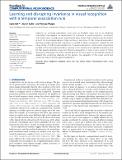Learning and disrupting invariance in visual recognition with a temporal association rule
Author(s)
Isik, Leyla; Leibo, Joel Z.; Poggio, Tomaso A
DownloadIsik-2012-Learning and disrupting invariance in visual recognition with a temporal association rule.pdf (827.3Kb)
PUBLISHER_POLICY
Publisher Policy
Article is made available in accordance with the publisher's policy and may be subject to US copyright law. Please refer to the publisher's site for terms of use.
Terms of use
Metadata
Show full item recordAbstract
Learning by temporal association rules such as Foldiak's trace rule is an attractive hypothesis that explains the development of invariance in visual recognition. Consistent with these rules, several recent experiments have shown that invariance can be broken at both the psychophysical and single cell levels. We show (1) that temporal association learning provides appropriate invariance in models of object recognition inspired by the visual cortex, (2) that we can replicate the “invariance disruption” experiments using these models with a temporal association learning rule to develop and maintain invariance, and (3) that despite dramatic single cell effects, a population of cells is very robust to these disruptions. We argue that these models account for the stability of perceptual invariance despite the underlying plasticity of the system, the variability of the visual world and expected noise in the biological mechanisms.
Date issued
2012-06Department
Massachusetts Institute of Technology. Computational and Systems Biology Program; Massachusetts Institute of Technology. Department of Brain and Cognitive Sciences; McGovern Institute for Brain Research at MITJournal
Frontiers in Computational Neuroscience
Publisher
Frontiers Research Foundation
Citation
Isik, Leyla, Joel Z. Leibo, and Tomaso Poggio. “Learning and Disrupting Invariance in Visual Recognition with a Temporal Association Rule.” Frontiers in Computational Neuroscience 6 (2012).
Version: Final published version
ISSN
1662-5188